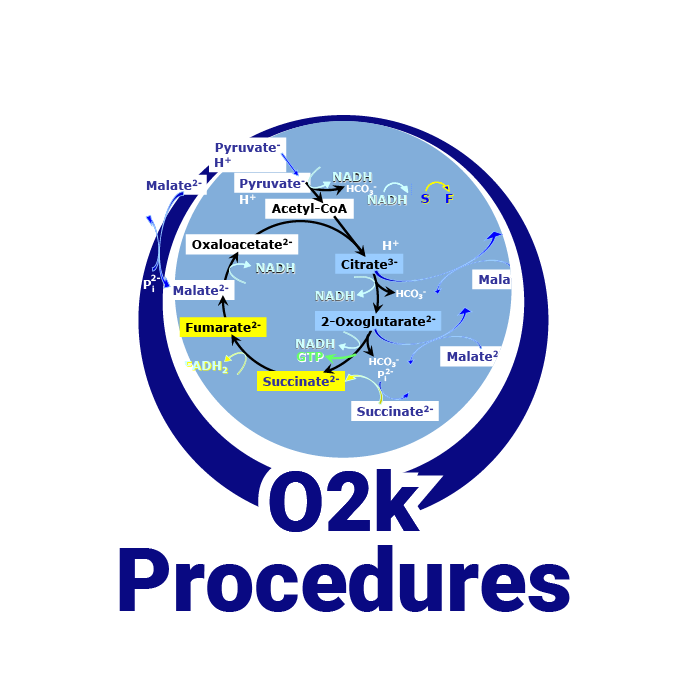Difference between revisions of "Talk:Raw signal of the oxygen sensor"
From Bioblast
| (13 intermediate revisions by 4 users not shown) | |||
| Line 1: | Line 1: | ||
[[Image:BB-Bioblast.jpg|left|40px|link= | [[Image:BB-Bioblast.jpg|left|40px|link=Bioblast:About|Bioblast wiki]] | ||
== Popular Bioblast page == | == Popular Bioblast page == | ||
::: [[ | ::: [[Raw signal]] has been accessed more than | ||
::::* 5,000 times ( | ::::* 5,000 times (2018-10-19) | ||
{{Technical support}} | |||
__TOC__ | |||
{{MitoPedia without banner | |||
|abbr=R | |||
|description=The '''raw signal''' of the polarographic oxygen sensor (POS) reflects the number of O<sub>2</sub> molecules reacting with the sensor. Calibration of the raw signal with the known air oxygen concentration at a given barometric pressure and temperature allows for exact measurement of the oxygen concentration in the O2k chamber. See ''O2k-Support page:'' '''[[Oxygen signal]]'''. Observation of the raw signal values is important for quality control and trouble-shooting procedures. | |||
|info=[[MiPNet06.03 POS-calibration-SOP]], [[MiPNet12.20_O2k-calibration_tutorial]] | |||
}} | |||
== DatLab 8 == | |||
[[File:DL8_status_line_arrows.png|thumb|right|800px|Raw data displayed in the status bar]] | |||
::; Raw signal display | |||
:::: The control panel at the very bottom of the measurement window shows the raw signal values. | |||
::; Typical values at atmospheric O<sub>2</sub> concentration | |||
:::: After equilibration with the stopper in [[Open_chamber|open chamber]] position, the raw signal should be close to 2 µA (values between 1 and 3 µA are acceptable at temperatures between 25 and 37 °C and altitudes up to 1000 m above sea level). | |||
:::: | ::; Typical values at 'zero oxygen' | ||
:::: After O2 removal from the O2k chamber by dithionite or oxygen consuming biological samples, the raw signal should be stable and < 2% of the signal at air saturation, but < 5% is acceptable. | |||
:::: A raw signal of more than 5 % of air saturation level should be addressed by a service of the polarographic oxygen sensor. | |||
== DatLab 7 == | |||
: | [[File:DL7_raw_values_arrows.png|thumb|right|400px|Raw data displayed in the status bar]] | ||
:: | ::; Raw signal display | ||
:::: Raw data from the POS are shown together with other readings in the bottom status bar, the second value refers to chamber A, the third to chamber B (see orange arrows) | |||
::; Typical values at atmospheric O2 concentration | |||
:::: After equilibration with the stopper in [[Open_chamber|open chamber]] position, the raw signal should be close to 2 V (values between 1 and 3 V are acceptable at temperatures between 25 and 37 °C and altitudes up to 1000 m above sea level). | |||
::; Typical values at 'zero oxygen' | |||
:::: After O2 removal from the O2k chamber by dithionite or oxygen consuming biological samples, the raw signal should be stable and < 2% of the signal at air saturation, but < 5% is acceptable. | |||
:::: A raw signal of more than 5 % of air saturation level should be addressed by a service of the polarographic oxygen sensor. | |||
{{MitoPedia O2k and high-resolution respirometry | |||
|mitopedia O2k and high-resolution respirometry=DatLab | |||
}} | |||
Latest revision as of 12:38, 11 March 2022
Popular Bioblast page
- Raw signal has been accessed more than
- 5,000 times (2018-10-19)
- Raw signal has been accessed more than
 |
Talk:Raw signal of the oxygen sensor |
MitoPedia O2k and high-resolution respirometry:
O2k-Open Support
Description
The raw signal of the polarographic oxygen sensor (POS) reflects the number of O2 molecules reacting with the sensor. Calibration of the raw signal with the known air oxygen concentration at a given barometric pressure and temperature allows for exact measurement of the oxygen concentration in the O2k chamber. See O2k-Support page: Oxygen signal. Observation of the raw signal values is important for quality control and trouble-shooting procedures.
Abbreviation: R
Reference: MiPNet06.03 POS-calibration-SOP, MiPNet12.20_O2k-calibration_tutorial
DatLab 8
- Raw signal display
-
- The control panel at the very bottom of the measurement window shows the raw signal values.
- Typical values at atmospheric O2 concentration
-
- After equilibration with the stopper in open chamber position, the raw signal should be close to 2 µA (values between 1 and 3 µA are acceptable at temperatures between 25 and 37 °C and altitudes up to 1000 m above sea level).
- Typical values at 'zero oxygen'
-
- After O2 removal from the O2k chamber by dithionite or oxygen consuming biological samples, the raw signal should be stable and < 2% of the signal at air saturation, but < 5% is acceptable.
- A raw signal of more than 5 % of air saturation level should be addressed by a service of the polarographic oxygen sensor.
DatLab 7
- Raw signal display
- Raw data from the POS are shown together with other readings in the bottom status bar, the second value refers to chamber A, the third to chamber B (see orange arrows)
- Typical values at atmospheric O2 concentration
-
- After equilibration with the stopper in open chamber position, the raw signal should be close to 2 V (values between 1 and 3 V are acceptable at temperatures between 25 and 37 °C and altitudes up to 1000 m above sea level).
- Typical values at 'zero oxygen'
-
- After O2 removal from the O2k chamber by dithionite or oxygen consuming biological samples, the raw signal should be stable and < 2% of the signal at air saturation, but < 5% is acceptable.
- A raw signal of more than 5 % of air saturation level should be addressed by a service of the polarographic oxygen sensor.
MitoPedia O2k and high-resolution respirometry: DatLab






